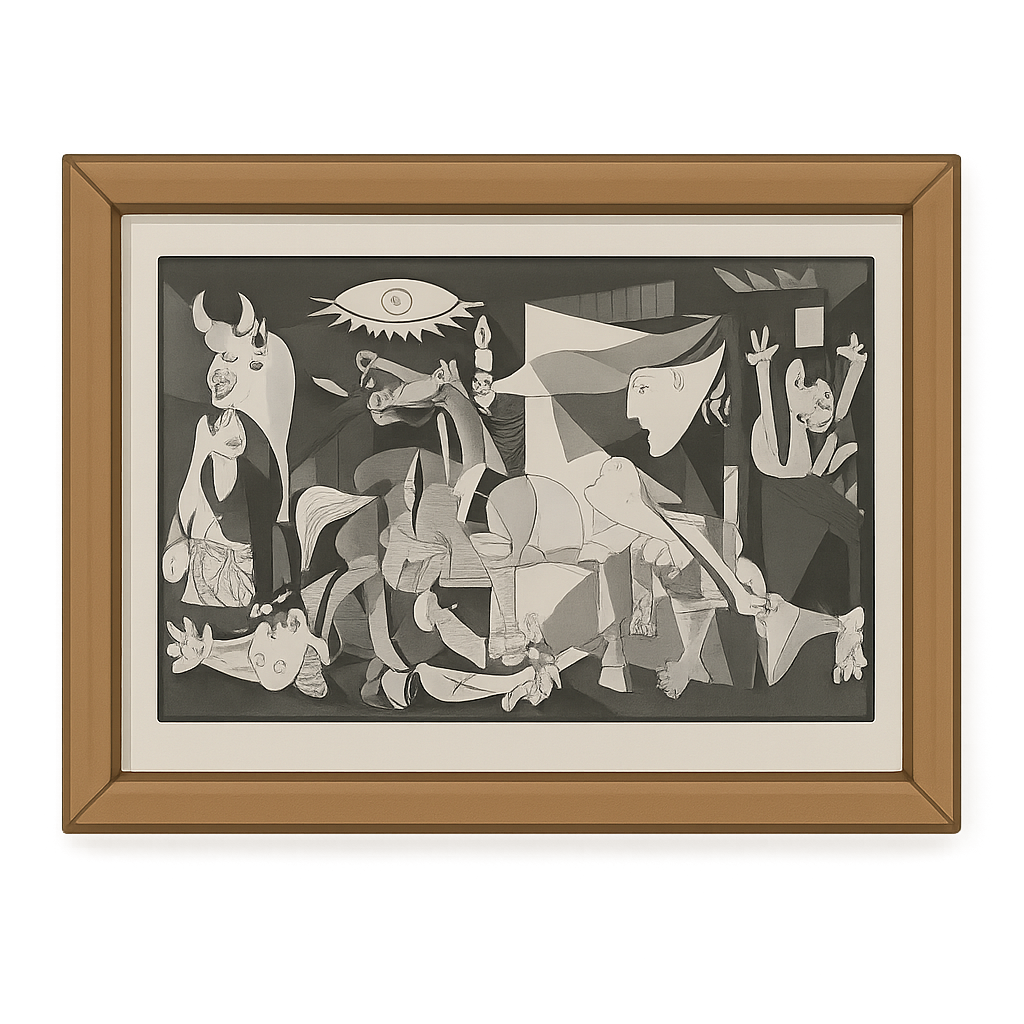Guernica: A Story in Black and White
Imagine being a world without a single drop of color. No blue sky, no green grass, just shades of black, white, and gray stretched across a canvas as wide as a school bus. That’s me. I am enormous. At first glance, I might look like a jumble of strange, sharp shapes. But I ask you to look closer. Can you see the horse in the center, its head thrown back and its mouth open in a silent, jagged scream? Over on the left, a mother clutches her child, her eyes wide with a sorrow so deep it needs no color to be understood. On the ground lies a brave soldier, his body in pieces, but his hand still grips a broken sword. It’s a lot to take in, I know. I wasn’t made to be a pretty picture hanging over a sofa. I was made to tell a story, a very important and sad story, using only shadows and light. I am a shout that you can see. I am Guernica.
My story begins with a man named Pablo Picasso. He was a famous artist from Spain, and his heart was as full of fire and passion as his paintings. In the spring of 1937, while he was living in Paris, he heard terrible news from his home country. A small, peaceful town called Guernica had been bombed. Innocent people were hurt, and their homes were destroyed. Picasso felt a storm of sadness and anger brewing inside him. He knew he couldn't fight with soldiers, but he could fight with his paintbrush. He needed a canvas big enough to hold all his feelings, a canvas as big as the side of a building. He decided to paint me. He worked with incredible speed, as if the feelings were pouring out of his hands. He chose not to use any colors—no reds, no blues, no yellows. Why? Because he wanted me to look like a newspaper article, telling the world the hard, true facts of what had happened. He wanted everyone to take the story seriously. Each shape he painted was a piece of the puzzle, a symbol. Can you see the big, strong bull on the left? Some say it represents the darkness and cruelty of war, while others see it as a symbol of Spanish strength. The screaming horse represents the suffering of innocent people and animals. Look up at the top. That bright, jagged shape isn't the sun; it's a bare lightbulb, like an eye that has seen this terrible event and will not look away. But even in all this sadness, Picasso left a tiny sign of hope. From the soldier's hand holding the broken sword, a single, small flower is growing. It’s a quiet promise that even after the worst things happen, new life and peace can begin again.
Once I was finished in 1937, my journey began. Pablo Picasso didn’t hide me away. He sent me to the Paris International Exposition, a huge world's fair where countries showed off their best inventions and art. When people saw me, they didn't just walk by. They stopped. They stared. Some felt sad, others felt angry, and many were confused by my sharp angles and colorless world. I wasn't the cheerful painting they expected to see at a fair, but I made them think, and that was my purpose. I became a traveler, a messenger for peace. For many years, I journeyed across the world, from Brazil to the United States. I was like a giant postcard from Picasso, reminding everyone of the tragedy of war and begging them to choose peace instead. Picasso had one important rule: I could not return to his home country of Spain until it was free and peaceful again. He wanted me to wait until the fighting and the harsh rulers were gone. For many decades, I waited in a museum in New York City. Finally, in 1981, long after Picasso had passed away, Spain was a peaceful democracy. It was time for me to go home. Today, I live in a special museum in Madrid, the capital of Spain. Thousands of people, including kids just like you, come to see me every year. They stand quietly and look for the horse, the mother, the bull, and the tiny flower. Though I show a dark and painful moment from history, my true job is to be a symbol of hope. I prove that art can have a powerful voice, one that shouts for peace across the years. I am a reminder that even in the darkest night, a small flower of hope can always find a way to grow.
Reading Comprehension Questions
Click to see answer
